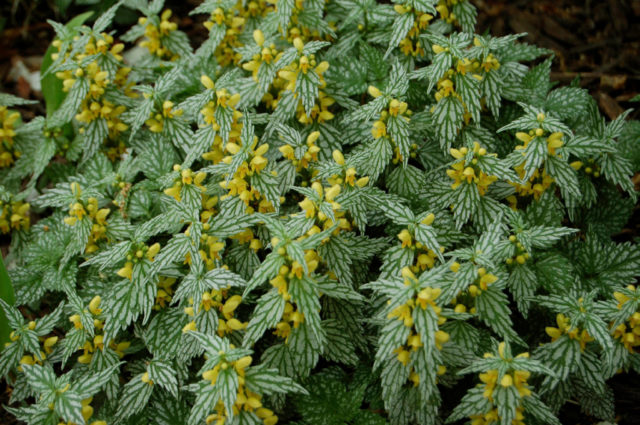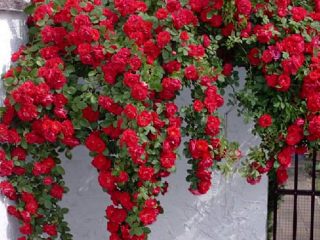Content
Greenweed (yellow) is a herbaceous perennial plant used by gardeners for landscaping. Wild upright varieties are used in landscape design, but groundcover varieties are also found. Yellow lily can be grown in any area without much difficulty. The plant is not picky and goes well with other ornamental crops.
Description and characteristics
Yellow lily (Galeobdolon luteum) is a herbaceous perennial, up to 30 cm high. The stems are creeping, well-rooted with soft fibers, light green in color. Peduncles are erect and can reach 60 cm in height.
The root system is fibrous. Because of this, the bush is able to fill the area with long shoots in a short period of time.

Every year the stems grow 50 cm or more
As the shoots grow, they cover the soil and the width of the bushes increases. By pruning, you can give it a dome-shaped shape. Some gardeners tie them to supports and trellises. In such cases, the growth of the bush slows down.
The shoots are densely covered with opposite leaves. They are ovoid, wrinkled, with small cilia near the petioles. The upper leaves are larger than the lower ones, with jagged edges.
Zelenchuk is characterized by short-term flowering. It begins in the middle or end of May, less often in June.
The shrub is highly frost-resistant. Greenweed tolerates winter without shelter. It is characterized by low sensitivity to frost and can withstand temperatures down to -35 degrees. Strong winds have a detrimental effect on it. It can lead to hypothermia of surface roots, especially in summer, if they are too dry.
Yellow lily does not tolerate prolonged drought. Due to the heat and lack of water, the shoots begin to dry out and become fragile. Excess moisture is also detrimental to the plant, as it provokes fungal diseases.
Flower structure
The buds are collected in stem whorls. They are located in the axils of the upper leaves. In the lower part of the bush, peduncles do not form. The opened buds do not have a pronounced aroma.
The bracts are linear, sharp, slightly bent downwards. There are small cilia on the edges. The sepals are bell-shaped, shorter than the bracts. The corollas are yellow, oblong, ovoid with four stamens.

Yasnotka prefers moderately moist fertile loams
Flowering of yellow damask lasts up to 3 weeks
It is recommended to immediately remove faded shoots from the bushes. Then new ones will form in their place, on which buds will also appear. This allows you to increase the flowering period, extending it until August.
In the photo of green cherry, rounded fruits are noticeable.Seeds are formed in them. As they mature, they open up.

Although it is shade-loving, it grows equally well in open sun.
Where does it grow
Yellow lily is common in many countries. Wild species grow in Asian countries, Russia and Eastern Europe. Some varieties are grown successfully in the North, including Sweden, Denmark and Norway.
Yellow damselfish is adapted to growing in well-moistened soils. Therefore, this plant is common in coniferous and deciduous forests. Under natural conditions, yellow damselfish reproduces by seeds, which are carried by insects and birds.
Varieties of common green chickweed
In landscape design, wild varieties of yellow grass are used. There are several common subspecies.
Among them:
- Florentitum.
- Montanum.
- Argentatum.
The most popular varieties of yellow damask are “Golden Nuggets” and “Golden Anniversary”. The main feature of such green chicks is that they have variegated foliage. It is dark green with a silver pattern.

Prolonged drought is harmful to the green grass
Varieties with variegated leaf colors are not recommended to be planted in the sun, otherwise they may lighten and lose their decorative effect.
Reproduction methods
The main method is dividing the bush. The plant tolerates this procedure very well due to its strong root system and fast-growing shoots. The advantage of division is also that it allows you to preserve varietal qualities.
The procedure is carried out in the spring season. The planting hole for a new plant is prepared in advance. The yellow claret bush is dug up and removed from the soil.It is necessary to separate shoots with strong roots on which young buds are present.
If you want to plant several new specimens nearby, you should allow the plant to shed its seeds. They have a high germination rate and many new bushes will appear next year.
Reproduction by cuttings is allowed. The material is cut in August and rooted in a moist substrate. After the roots appear, the cuttings are transplanted into a container in which they are kept until next year.
Planting and caring for Laminaria zelenchukova
It is not difficult to grow a beautiful ground cover shrub on your site. To do this, it is enough to follow a few simple rules and properly care for the plant.
Landing dates
Depends on the planting material. Many people grow yellow grass from seeds. They need to be sown in mid-spring when persistent warming sets in. Planted directly into the ground.
Young plants obtained by cuttings are planted in the soil in May. Constant air temperature should not fall below 8 degrees.
Requirements for place and soil
For yellow clasp, areas located in partial shade are best suited. Excess sunlight negatively affects the condition of the plant, especially in summer, in hot weather.
The soil on the site should be loose and well moistened. The plant is insensitive to low nutrient content in the soil. But in order for the yellow grass to bloom regularly and profusely, you should choose places with fertile soil.
It is not recommended to plant in soil containing excess nitrogen.Otherwise, the bush will grow too quickly and may harm other plants.
Planting and care
First of all, you need to prepare the area for sowing. Remove all weeds. The soil should be dug up and leveled if necessary.
Sowing yellow grass seeds:
- Dig shallow grooves.
- Fill the recesses with water.
- Place the seeds on the bottom at a distance of 5-6 cm from each other.
- Sprinkle with a thin layer of loose soil.
- Spray water on top.
The first shoots appear after 8-10 days. When the seedlings grow slightly, you can remove the excess ones. In the early stages, abundant watering is not required. It is carried out only if there is no precipitation for a long time.

Yellow lily blossoms in the second year after planting in open ground
One of the important advantages of the described plant is that it prevents the growth of weeds. Therefore, it does not need weeding. As the bush grows, it is necessary to periodically shorten the surface roots, otherwise they can harm nearby plants.
Mature plants require regular watering. Due to the dense foliage, the bushes need a lot of water. 15-20 liters are used for each. Irrigation is carried out 1-2 times a week to prevent waterlogging.
Mineral fertilizing is not required for the yellow damselfish. The bush is fertilized once a year, in the spring, before flowering begins. In this case, organic sources of nutrients are used.
After flowering, the buds are removed from the shoots. Fruits in which seeds are formed also need to be removed to prevent self-seeding.
Due to prolonged drought, yellow lariat can be affected by spider mites, scale insects and whiteflies. Such pests can cause serious damage to the plant.For prevention, the bush needs to be treated with an insecticidal agent once every 2 months.
Before wintering, dry shoots are removed from the bushes. It is not necessary to cover the plant. To keep the roots from freezing, it is recommended to hill them with loose soil mixed with dry leaves, sawdust or bark. In spring they will become an additional source of nutrients for the plant.
Yasnotka zelenchukova in landscape design
Laminaria is actively used for decorative purposes. Thanks to its rapid growth, it can green a large area in a short period of time. At the same time, the shoots spread and grow in width, which is why the bush becomes voluminous.
Yellow lily is used to decorate various landscape elements:
- curbs;
- artificial reservoirs;
- garden buildings;
- verandas, loggias.
Laminaria is often grown in flowerpots as an hanging plant. Regular haircuts give it the correct shape.

Zelenchuk is often used for planting next to other low-growing shrubs.
Yellow lily is ideal for planting in shaded areas where other flowering shrubs cannot be planted. With the help of such a plant you can decorate various compositions and create a background for other crops.
Conclusion
Greenweed is a common plant used for decorative purposes. The shrub is valued by gardeners and designers for its ease of care and rapid growth rate. Despite the short flowering, it remains decorative all year round due to its beautiful dense foliage. The shrub can be grown in almost any conditions, as it is resistant to cold and shade-tolerant.








